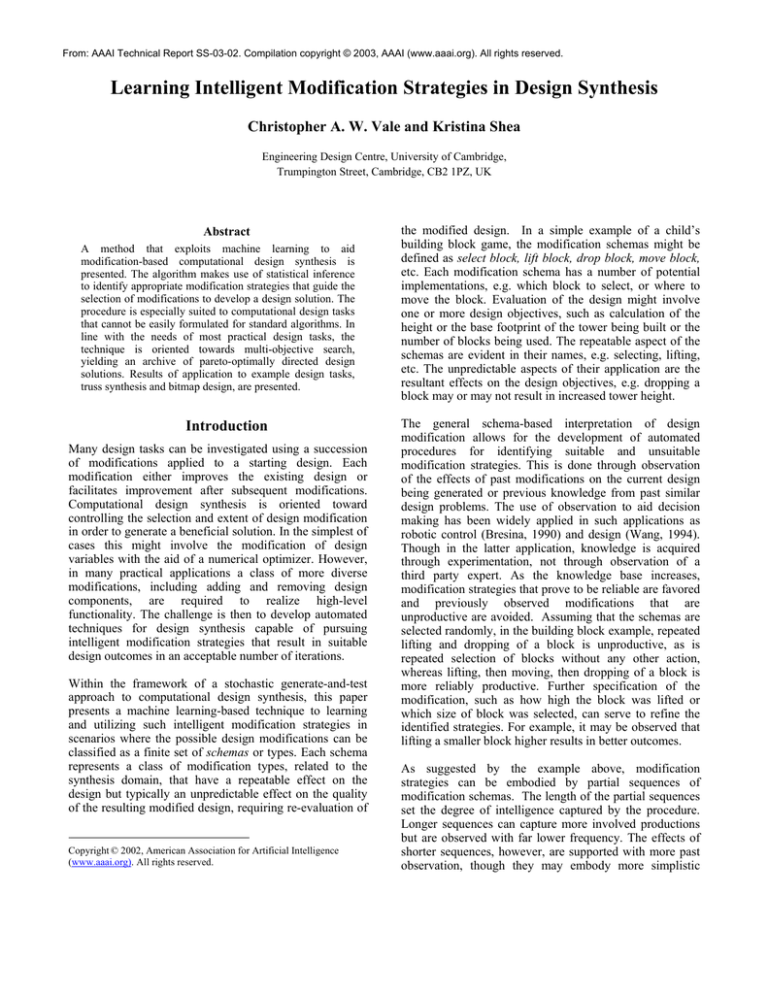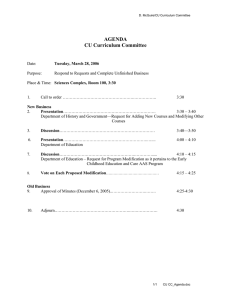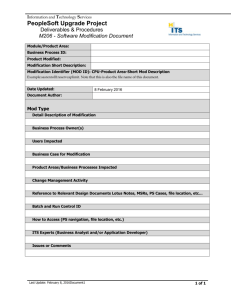
From: AAAI Technical Report SS-03-02. Compilation copyright © 2003, AAAI (www.aaai.org). All rights reserved.
Learning Intelligent Modification Strategies in Design Synthesis
Christopher A. W. Vale and Kristina Shea
Engineering Design Centre, University of Cambridge,
Trumpington Street, Cambridge, CB2 1PZ, UK
Abstract
A method that exploits machine learning to aid
modification-based computational design synthesis is
presented. The algorithm makes use of statistical inference
to identify appropriate modification strategies that guide the
selection of modifications to develop a design solution. The
procedure is especially suited to computational design tasks
that cannot be easily formulated for standard algorithms. In
line with the needs of most practical design tasks, the
technique is oriented towards multi-objective search,
yielding an archive of pareto-optimally directed design
solutions. Results of application to example design tasks,
truss synthesis and bitmap design, are presented.
Introduction
Many design tasks can be investigated using a succession
of modifications applied to a starting design. Each
modification either improves the existing design or
facilitates improvement after subsequent modifications.
Computational design synthesis is oriented toward
controlling the selection and extent of design modification
in order to generate a beneficial solution. In the simplest of
cases this might involve the modification of design
variables with the aid of a numerical optimizer. However,
in many practical applications a class of more diverse
modifications, including adding and removing design
components, are required to realize high-level
functionality. The challenge is then to develop automated
techniques for design synthesis capable of pursuing
intelligent modification strategies that result in suitable
design outcomes in an acceptable number of iterations.
1
Within the framework of a stochastic generate-and-test
approach to computational design synthesis, this paper
presents a machine learning-based technique to learning
and utilizing such intelligent modification strategies in
scenarios where the possible design modifications can be
classified as a finite set of schemas or types. Each schema
represents a class of modification types, related to the
synthesis domain, that have a repeatable effect on the
design but typically an unpredictable effect on the quality
of the resulting modified design, requiring re-evaluation of
Copyright © 2002, American Association for Artificial Intelligence
(www.aaai.org). All rights reserved.
the modified design. In a simple example of a child’s
building block game, the modification schemas might be
defined as select block, lift block, drop block, move block,
etc. Each modification schema has a number of potential
implementations, e.g. which block to select, or where to
move the block. Evaluation of the design might involve
one or more design objectives, such as calculation of the
height or the base footprint of the tower being built or the
number of blocks being used. The repeatable aspect of the
schemas are evident in their names, e.g. selecting, lifting,
etc. The unpredictable aspects of their application are the
resultant effects on the design objectives, e.g. dropping a
block may or may not result in increased tower height.
The general schema-based interpretation of design
modification allows for the development of automated
procedures for identifying suitable and unsuitable
modification strategies. This is done through observation
of the effects of past modifications on the current design
being generated or previous knowledge from past similar
design problems. The use of observation to aid decision
making has been widely applied in such applications as
robotic control (Bresina, 1990) and design (Wang, 1994).
Though in the latter application, knowledge is acquired
through experimentation, not through observation of a
third party expert. As the knowledge base increases,
modification strategies that prove to be reliable are favored
and previously observed modifications that are
unproductive are avoided. Assuming that the schemas are
selected randomly, in the building block example, repeated
lifting and dropping of a block is unproductive, as is
repeated selection of blocks without any other action,
whereas lifting, then moving, then dropping of a block is
more reliably productive. Further specification of the
modification, such as how high the block was lifted or
which size of block was selected, can serve to refine the
identified strategies. For example, it may be observed that
lifting a smaller block higher results in better outcomes.
As suggested by the example above, modification
strategies can be embodied by partial sequences of
modification schemas. The length of the partial sequences
set the degree of intelligence captured by the procedure.
Longer sequences can capture more involved productions
but are observed with far lower frequency. The effects of
shorter sequences, however, are supported with more past
observation, though they may embody more simplistic
productions and therefore may be less useful. The
algorithm presented here takes a statistical observationbased approach to machine learning using an architecture
comprised of two elements. The first, termed the
modification sequence modeler, analyses the effects of
sequences of modification schemas on the design
objectives, also taking into account implementation
specifics that detail how the modification schemas are
applied. These observations form a statistical database that
allows inference of the possible future effects of sequences
of modifications. The second element, termed the
modification advisor, uses the sequence models to rate
potential imminent modifications based on the history of
past modifications and design objectives. Highly rated
modifications typically facilitate sequences that are
favorable to the future development given its current state.
To illustrate the robustness and wide applicability of the
approach, it is applied to two diverse problem scenarios.
The first involves the multiobjective design of planar truss
structures with the aid of shape grammar modification
rules. In this capacity, the procedure exhibits a higher
degree of search efficiency when applied in conjunction
with a stochastic multiobjective optimization scheme. A
second synthesis task is the design of bitmap patterns using
a sliding tile modification formalism where increases in
search efficiency result in improved final designs in a
limited number of modification-analysis iterations.
This paper first outlines the ‘modification-based design’
framework before presenting an overview of the design
algorithm. The next two sections deal with the two
components of the algorithm in greater detail. The results
of application of the algorithm to sample design tasks are
then presented before conclusions and an outlook for
further work are discussed.
Modification-Based Design
Modification-based design describes a process by which
one or more designs are gradually changed through
successive applications of modification operators.
Typically, the design algorithm seeks to implement
modifications that lead to improved designs after a number
of modifications have been made. Implementation of the
modifications and evaluation of the resulting new designs
demand computational resources and, as a result, it is
desirable to minimize the number of modificationevaluation iterations in the design process. The framework
described above not only accounts for simple optimization
tasks but also more complex design formalisms where the
modifications employed not only modify but also introduce
and remove design variables. An example of such a
formalism used in the design of pin joint planar truss
structures is summarized by figure 1 (Shea, 1997). A set of
modification schemas are shown that can be applied
iteratively to generate an infinite number of planar truss
topologies.
R2
R1
R4
R3
R1: Node addition (single member)
R3: Node removal (single member)
R2: Node addition (double member)
R4: Node removal (double member)
R7
R6
R6: Diagonal flip
R7: Node Movement
Figure 1. The truss modification rules. (Rule application
locations are defined by crosshair indicators)
Initial Truss
R1
R7
Single Member Addition
R1
82
Node Movement
Single Member Addition
R6
Node Movement
R7
Diagonal Member Flip
No. Nodes
78 5
Mass [kg]
4
74
3
Figure 2. Development of a truss through application of
grammar rules
Figure 2 shows the development of a typical loaded planar
truss through repeated application of the rules. Note that
with each application of the modification rules, design
objectives, such as truss mass and number of nodes can
change. Truss design will be revisited later as an example.
It should be noted that the generate-and-test synthesis
approach in conjunction with a modification-based
formalism supports a bottom-up synthesis model, which
does not bias synthesis by prescribing a design process,
thereby allowing the generation of novel design solutions.
In addition to a basic modification rule type, such as shown
in Fig 1, modifications may also be further qualified by
application variables, providing a more complete
description of the applied modification. In the example
above, such a parameter may be the point of application of
the modification rule in Cartesian co-ordinates. Each
modification type is assigned an integer label from 1 to NR,
with NR the total number of modification types. In the truss
example above, NR = 7. In combination, the modification
type label and the application variables provide a detailed
description of each rule application. However, it will be
shown later that is it preferable to keep the number of rule
types and application variables low as a higher level of
specification requires more data samples to support
statistical inference through observation.
Algorithm Overview
Observing the effects of modification sequences
The algorithm is incorporated as two modules into a
standard generate-and-test computational synthesis
framework as shown in figure 3. The modification
sequence modeler is responsible for analyzing the past
effects of sequences of modifications and inferring future
behavior. The modification advisor uses the accumulated
knowledge of the modification sequence modeler together
with analysis of the current design state to suggest the most
suitable modifications to make on the next iteration. There
are a number of implementation possibilities for each
module.
A sample of the progress of a typical search in a multiobjective design problem is captured in Table 1. Referring
to the table, if the current iteration is 193, then the search
has just applied modification type 1 to the outcome of
iteration 192. In so doing, it has completed a single
modification sequence, <1>, a double modification
sequence, <3-1>, and a triple modification sequence, <1-31>. Each sequence is completed subject to the application
variables listed in the last column.
MODIFICATION
SEQUENCE
MODELER
MODIFICATION
EFFECTS
MODIFY
DESIGN
Obj.
Values
Before
Obj.
Values
After
Rule
Applied
Application
Variables
∈[1,NR]
[v1; v2; v..]
…
…
…
…
…
191
[1.0; 3.0]
[0.2; 6.0]
1
[0.2; 1.0]
192
[0.2; 6.0]
[0.1; 8.0]
3
[0.1; 0.1]
193
[0.1; 8.0]
[0.4; 1.0]
1
[1.0; 3.0]
…
…
…
…
…
Iterate
INITIAL DESIGN
EVALUATE
DESIGN
Table 1. Sample output of a search procedure
MODIFICATION
ADVISOR
Figure 3. An iterative generate-and-test search procedure
(e.g. simulated annealing) augmented by learning.
Two basic approaches have been investigated in this
research. The first and more simpler uses the data captured
by the modification sequence modeler to assign a figure of
merit to each sequence or segment, thereof. The
modification advisor then rates the possible imminent
modifications based on the scores of the sequences they
would contribute to. Parallels can be drawn with
reinforcement learning techniques (Mitchell, 1997) where
the figure of merit is associated with the standard
penalty/reward system.
The second approach, which is detailed here, uses the
recorded data to predict the probability distribution of
future objective values due to imminent modifications
being made. Based on the predicted outcomes the
modification advisor rates imminent modifications
according to their potential to produce results.
The Modification Sequence Modeler
The modification sequence modeler encompasses
recording and analyzing the effects of sequences of
modifications on the design objectives.
In this
implementation of the technique, it provides a model that
allows prediction of the effects of future modifications
based on known recent modifications and the
corresponding objective values.
By looking even further back into the history of
modification applications, it is possible to observe the
effects of arbitrarily long sequences of modifications.
However, as the length of the modeled sequences
increases, so do the number of possible sequences,
implying that within a finite observation time, there will be
fewer observed effects per sequence to support inference
of the effects of each sequence. Currently, the algorithm
models at fixed pre-defined sequence lengths, though
further research will develop modelers capable of
dynamically varying the modeled sequence length as the
number of observations increase.
Assuming, for the purposes of explanation, that the
algorithm is modeling at the level of two modifcations per
sequence, it will then concern itself only with the just
completed <3-1> sequence. The algorithm calculates the
changes in objective values:
After
Before
∆O <3−1>| v = O 193
− O 192
(1)
After
Before
∆O <1>|<3> , v = O 193
− O 193
(2)
The change in objectives in Eqn. (1) is due to the complete
double rule sequence, while that in Eqn. (2) is the change
in objective from when modification type 3 has been
applied to the end of the sequence. For an NS length
sequence, there will be NS changes in objective values
sampled in this fashion at each iteration. In this way, all
sequences of length equal to, or shorter than the current
level of sequence length modeling are recorded. Note that
the observations can be made subject to the application
variables, v, which would more completely describe the
sequence.
Subdividing sequences
An additional task of the modification sequence modeler is
to group observed sequence effects according to the
application variables in so that, for any particular
sequence, each subdivision exhibits differing effects on the
design objectives when applied within a particular range of
application variables. Figure 4 plots the observed change in
truss mass for a truss design problem over the sequence of
modifications <1-3> as a function of a single application
variable defined here as the geometric distance separating
the application of the first and second modifications in the
sequence.
It can be seen that the observed changes in the mass are
generally much wider spread out in the middle ranges of
geometric separation. When the separation distance was
zero, all the observed changes in mass were also zero. This
is to be expected for the truss grammar, as rules 1 and 3 are
a rule/anti-rule pair. <1-3> applied with zero distance
separating them amounts to addition and immediate
removal of a node, leaving the truss unchanged. With the
general effect of <1-3> clearly changing as a function of
the application variables, each general sequence can be
resolved into discrete segments, S1..N, chosen so that the
difference in the statistical properties (mean and variance)
of the observed changes in objective values of neighboring
segments is maximized. In Figure 4, the segments that
result from subdivision are indicated by vertical lines.
S1
S3
S2
S5
S4
considering all the levels of observation at once and
subdividing the sequence so that the biggest grouping
patterns over all the levels of observation decide the
segments of the sequences.
S
S1
S
S3
S4
S3
S4
S2
Figure 5. Multi-level subdivision of <6-6> in a truss problem
Although not done in this implementation, it would be
possible and more appropriate to consider each level of
observation in turn, generating NS×NO sets of segments for
each sequence (with NO equal to the number of objectives).
Further research and development of the approach will
address this issue. Figure 5 plots the two levels of observed
changes in mass for a sample truss design problem using
the truss modification rules for the <6-6> sequence
showing the resulting segments in different greys for the
set of observations.
In multiobjective problems, subdivision is performed
independently for each objective, resulting in differently
segmented sequences for each objective.
Modelling the Observed Data as Mixture
Gaussian Distributions (MGDs)
Figure 4. Changes in objective due to <1-3> as a function of the
segmentation variable.
In this implementation, subdivision is not only applied to
the highest level of observed change in objectives, e.g.
∆O<1-3> as above, but also applied to multi-level observed
data, e.g. ∆O<3>|<1> in the example above.
As with some other components of the system to be
presented later, implementation of the subdividing
algorithm is beyond the scope of this paper. More detail of
their implementation can be found in (Vale 2002).
Effectively this algorithm finds a ‘happy medium’ by
In this implementation, the distributions of changes in
objective associated with each segment are used to aid
prediction of future objective values. It serves our purpose
to approximate the observed frequency distribution plots as
mixture gaussian distributions (Vaseghi 1996) to aid the
prediction mechanisms to be used later. MGDs are formed
by a weighted sum of gaussian (normal) distributions and
possess certain favourable statistical qualities including a
simple and fast convolution process. The MGDs are
generated for each level of observed changes in objective,
in each segment and for each objective independently. The
operation is performed immediately after subdivision of
the sequences. Figure 6 shows some of the mixture
gaussian distributions resulting from the segments of the
<6-6> sequence shown in Figure 5. Note the impulse
functions that result from strong inclinations for zero
change in objective.
Figure 6. MGD models of some of the distributions form Figure 5.
Objective Prediction and Hypothesis Evaluation
Given the MDG models of the past effects of sequences of
modifications, it is possible to infer the probability
distribution functions of future objective values given
knowledge of the modifications and objective values for
the past NS – 1 iterations.
Consider the task of predicting the objective value
distribution after a single modification is applied to the
current design. Application of a modification type, t, will
complete a sequence, <…-r-s-t>, Given that all the levels
of observed changes in objectives have been modelled and
that the objective values for the last NS – 1 iterations are
known, there are now NS possible hypotheses for the
probability distribution of the objective value resulting
from application of modification type t corresponding to
each of the observed levels within the sequence. Which
hypothesis yields a more accurate prediction depends on
the nature of the interaction between subsequent
modifications in the sequence and is specific to the
particular sequence (and/or segment thereof). In this
implementation, the hypotheses are assessed on an ongoing basis throughout the search procedure, by the
modification sequence modeller. This is done by
comparing the predictions of the various hypotheses with
what is observed to occur during the search. Each
hypothesis within a sequence is then assigned a dynamic
quality metric through these observations. The details of
the hypothesis evaluation and scoring procedure are
beyond the scope of this paper but can be found in (Vale
2002).
The procedure above for predicting a single iteration in the
future can be extended in a similar fashion for predicting
up to NS iterations away, though it should be noted that as
the predictions become more long-term, the ability of the
inferred future objective value probability distributions to
aid short term decision making decreases.
Also worthy of note is the fact that objective distribution
prediction may result in a future probability distribution
function close to an impulse function. In truss design, for
example, the <1-3> sequence applied with rules 1 and 3 in
close proximity always leads to zero change in the truss
mass over the sequence. In such cases, where the
prediction mechanism is certain of the exact value of the
future objective value, it may actually be used in lieu of the
true objective evaluation module. The effects of exploiting
this side-effect of the algorithm are shown later.
The Modification Advisor
The purpose of the modification advisor is to provide an
ordered list of appropriate modifications to make on the
next iteration. It is comprised of three primary submodules, each invoked in turn at each iteration.
The Performance Observer
When the complexity of escaping local optima exceeds the
scope of the sequence models, the procedure can trap itself
by strictly following its preferential treatment of ‘good’
design strategies. The role of the performance observer is
to analyze the convergence of the archive of solutions and
instruct completely random modifications if local
convergence is observed. As soon as an advance is made,
the Modification Advisor switches back to its standard
practice. Under this regime the search exhibits rapid
archive development and high efficiency until it reaches a
point where a higher level of creativity is required. The
performance observer uses an exponential distribution of
observed advances made throughout the search to detect
when the probability that an advance in the search should
have occurred. If this probability exceeds a threshold
value, local convergence is assumed and random
modifications then provide a burst of creativity before the
algorithm switches back to using the more informed
search.
The Pareto Navigator
Relevant only in multiobjective problems, the aim of the
pareto navigator is to provide an indication of the most
suitable change in objective values to best explore the
Pareto frontier given the past search history and the current
location in objective space. Typically, it tries to steer the
search away from areas that have been well searched with
little success, as well as objective values excessively far
away from the developing archive of Pareto-optimal
Solutions. The Pareto Navigator outputs a metric. Mw, for
each objective, w, in the interval [-1,1], with –1 or 1
indicating a strong need to decrease or increase the
corresponding objective respectively. The magnitude of the
metric stresses the importance of the change. Zero
indicates that changes of the objective are irrelevant at the
current iteration. Implementation details can be found in
(Vale, 2002).
The Modification Ranker
The primary difficulty in ranking imminent modifications
is that of associating a utility or score to each possible
imminent modification. This is the responsibility of the
modification ranker, which forms the heart of the
algorithm. In this implementation the algorithm compares
the ultimate outcomes of its imminent decisions, much like
a chess algorithm, and selects the imminent modification
that promises the best long-term future.
Figure 7 summarizes how the modification ranker assigns
a utility score, u, to each potential imminent modification
for the example situation where NS = 3, the total number of
modification types is two and there is only one objective.
In the figure, a sequence, <1-2-1>, has just been
completed. Since it is not necessarily certain that a
modification will be able to be applied to the design at an
arbitrary iteration, there is an associated probability of
application for each modification type. In this
implementation, this figure is inferred through observation
of past attempts at applying modifications. More accurate
probabilities of application can be determined with more
complex models (also potentially sequence-based) or
through user intuition. Note that in some cases,
modifications may be applicable with 100% certainty.
Using the prediction model, the modification ranker can
predict the objective value probability distributions
arbitrarily far into the future. In this case, this is done to a
range of NS iterations. The objective value distributions
that result are shown, as well as those of earlier iterations.
improvement for a particular distribution. Improvement is
defined as the magnitude of the difference between the
current objective value and the future objective value in the
currently desired direction of change. The probability of
improvement is found from the probability distribution
function and the corresponding value of improvement. The
Z score found in this way corresponds to the utility at the
prediction horizon.
Propagation of the utilities. Once assigned, the utilities at
the prediction horizon must ‘propagate back’ to the
imminent decision point. This is done using weighted
summation of the utilities based on the rule application
probabilities, PR, according to the principles of sequential
decision making (Bernardo, 1998). The calculations
performed by the algorithm to determine the imminent
utility for rule 1 are shown in figure 7.
Combining utilities and ranking modifications. Having
determined the utilities for each objective in turn using the
approach outlined above, the algorithm then calculates a
combined score for each imminent modification using a
weighted sum of the utilities, where the weights
correspond to the magnitudes of the metrics, Mw from the
pareto navigator for all W design objectives.
A weighted roulette wheel ranks imminent modifications
with weights equal to the combined utility scores.
Probability that modification
types will be applicable to the
design:
Obj. Value = 70
R2
Obj. Value = 76
R1
u(1)
Current Iterate
= 0.5(0.5385) + 0.5(0.7)(0.365)
= 0.3970
u(2) = 0.44
R1
u(1,1)
= 0.7(0.5) + 0.3(0.5)(0.1)
= 0.365
u(1,2)
= 0.5(1) + 0.5(0.7)(0.11)
= 0.5385
R1
u(1,1,1) = 0.5
Distribution Scoring. Each final distribution outcome at
the prediction horizon is assigned a score, Z, based on its
properties. The scoring mechanism favours distributions
that promise a high certainty of large improvement in the
objective value (whether that may be higher or lower than
the current value). Essentially the score corresponds to the
maximum possible value of improvement × probability of
R1
P1 = 0.7
P2 = 0.5
R1
-
Z = 0.5
R2
u(1,1,2)
= 0.1
R2
u(1,2,1)
= 0.11
u(1,2,2) = 1
R1
-
Z = 0.1
R2
-
Z = 0.11
-
Z =1
Figure 7. The calculation of utilites for imminent modifications.
Application to Design Tasks
The algorithm presented was applied to two sample design
tasks. The first involves truss design using the shape rules
described earlier. The second deals with bitmap design.
Truss Design – Cantilever Example
The first example is the design of a cantilever truss
structure. The starting structure and loadings are given in
Figure 8. Figure 9 shows the typical output of a basic
search algorithm, which simply applies rules at random,
archiving any new non-dominated solutions discovered in
the process. In the context of Pareto optimality, a nondominated solution implies one that is unbeaten in at least
one of its objectives, by all other solutions found. Also
shown in the figure are some of the corresponding design
topologies. Note that the solutions approach the known
optimal Prager topology for the cantilever design (Prager
1977). The trade-off between the number of nodes and the
truss mass is visible in the plot of archived objective
values.
of non-dominated solutions. The effective gain in
efficiency that results from use of objective value
prediction is clear from the figure. Here, the search
converged to the same archive in about half the number of
objective function evaluations used by the un-augmented
method. It should be stressed that the augmentation used
here only used a sequence modeling length of NS = 2. It is
expected that with longer sequence lengths the speed-up
effect will be greater.
ρ = 2700 kg/m3 E = 17.2 kN/cm2
91cm
445kN
Figure 10. Convergence of the cantilever example.
227.5cm
Figure 8. Cantilever truss design problem for minimum
mass/minimum number of nodes.
y
N:2
N:4
N:9
N:7
N:3
N:5
N:1
N:8
N:6
Sliding Tile Bitmap Synthesis
The second synthesis task revolves around the well-known
puzzle of sliding tiles. The classic version of this puzzle
consists of a number of tiles arranged in a frame in a gridlike arrangement with one tile missing, as shown in white
in Figure 11. When arranged correctly, the tiles typically
form an image or sequence of numbers. The challenge of
the puzzle is to reconstruct the proper arrangement of tiles
from an initial jumbled up arrangement by successively
sliding tiles into the free space.
Goal 1
y
N:4
N:2
Initial
N:5
N:1
N:6
y
N:2
y
N:2
N:1
N:4
N:1
Goal 2
Figure 9. The cantilever truss solution archive
Figure 10 plots the average convergence for the developing
archive when augmenting simple random generate-and-test
synthesis with the technique presented here. Pareto
‘convergence’ is measured by calculating the hypervolume of objective space that is dominated by the archive
Figure 11. Sliding tile bitmap design task
This is a particularly interesting puzzle as it requires a
considerable amount of planning to solve successfully, but
is based on a very simple set of allowable actions. In this
investigation, the modification formalism is applied to
multiobjective design of dual-color bitmap images. The
initial bitmap image is a jumbled combination of the two
sets of grey tiles needed for the final images and one black
‘free space’. Each objective to be minimized is the
difference between the current bitmap and a unique ‘goal’
bitmap. Unless all the goal bitmaps match, it is impossible
to reduce all the objectives simultaneously to zero.
Expressed as a multiobjective problem, however, this
promises to reflect the trade-offs between conflicting goals
that might lead to the development of ‘morphed’ bitmaps
of varying degree, with the goal bitmaps obtained at the
extremes of the Pareto-front.
Figure 12 plots the average archive convergence for the
sliding tile bitmap synthesis task. Improvements in search
capability are afforded through use of this technique, with
the objective value prediction once again increasing
efficiency by more than 15%. Figure 13 plots some
examples of the archive members and the pareto front
discovered using this search method.
Conclusions
The learning technique presented represents a fully
automated means of accumulating and re-using effective
design modification knowledge for synthesis tasks,
resulting in increased synthesis efficiency and consequent
improvements in solution quality when using a finite
number of search iterations. The user benefits from
conclusions that can be drawn from the knowledge base
developed by the modification sequence modeler, which
can lead to improvements in the modification set and
insight into the nature of the problem. In both synthesis
tasks presented, the algorithm is shown to result in
improvements in exploration efficiency. It should however
be noted that in its current form, it is best applied to
problems where the modifications are generally applicable,
and there is uncertainty in the effect of the modifications
on the design objectives. Other classes of problems, such
as the constrained geometric knapsack problem (Cagan,
1993), which exhibit a high degree of uncertainty in the
applicability of modifications, and a co-incidentally high
degree of certainty in the effects of those modifications are
not well dealt with by this technique. Future research will
focus on overcoming these limitations.
Acknowledgements
Current research support is provided by the EPSRC (UK)
and a Philip Leverhulme Prize through the Leverhulme
Trust (UK).
References
Figure 12. Convergence of the sliding tile bitmap synthesis task.
Figure 13. The pareto-front and sample archive members in the
sliding tile problem.
Bernardo, J.M., Smith, A.F.M., “Sequential Decision
Problems,” in Bayesian Theory, John Wiley & Sons, 1998,
pp 13-104.
Bresina, J., Drummond, M., “Integrating planning and
reaction: A preliminary report,” in J. Hendler, editor, SRC
TR 90-45. Systems Research Center, University of
Maryland, 1990.
Cagan, J., and W.J. Mitchell (1993), "Optimally Directed
Shape Generation by Shape Annealing," Environment and
Planning B, 20:5-12.
Mitchell, T.M., Machine Learning, McGraw-Hill,
Singapore, 1997
Prager, W. ‘Optimal layout of Cantilever Trusses,’ Journal
of Optimization Theory and Applications, Vol. 23, no. 1,
Sept. 1977, pp. 111-117
Shea, K., Cagan J., Fenves, S.J. “A Shape Annealing
Approach to Optimal Truss Design With Dynamic
Grouping of Members,” Transactions of the ASME, Vol.
119, Sept. 1997, pp. 388-394.
Vale, C.A.W., Multiobjective Dynamic Synthesis via
Machine Learning, M.Phil Thesis, University of
Cambridge, UK, 2002.
Vaseghi, A.V. Advanced Digital Signal Processing and
Noise Reduction, John Wiley & Sons, ltd. New York,
1996, pp. 117-125.
Wang, X. “Learning planning operators by observation and
practice,” Proc. 2nd Intl Conf. AI Planning Systems, 1994.





